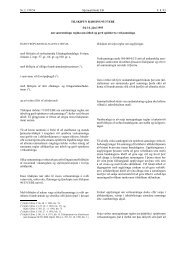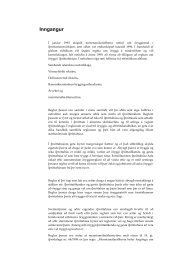Nomination of
Nomination of
Nomination of
Create successful ePaper yourself
Turn your PDF publications into a flip-book with our unique Google optimized e-Paper software.
SURTSEY – NOMINATION FOR THE UNESCO WORLD HERITAGE LIST<br />
surface temperatures <strong>of</strong> about 5° C. On average,<br />
the minimum temperature drops below 0° C on<br />
80 days <strong>of</strong> the year; however, since the maximum<br />
exceeds 0° C on most <strong>of</strong> those days, round-theclock<br />
freezing is only experienced for 18 days per<br />
year, on average. The frost-free period lasts on<br />
average for 5 to 7 months; during the last 50<br />
years, the longest frost-free period lasted 8<br />
months and the shortest about 15 weeks.<br />
Maximum temperatures in excess <strong>of</strong> 20° C are<br />
quite rare; Stórhöfði has experienced only 2 such<br />
days during the last 85 years. Frost below -15° C<br />
is also extremely rare.<br />
Stórhöfði receives ample precipitation,<br />
totalling annually about 1600 mm. Whereas June<br />
is the driest month <strong>of</strong> the year (93 mm), October<br />
comes out on average as the wettest month (156<br />
mm), though in fact the entire fall and winter<br />
period from August to March resembles October<br />
(Fig. 2.8). Snowfall is rather slight; in fact, its sum<br />
(60 mm) comprises only around 4% <strong>of</strong> the total<br />
annual precipitation. A mixture <strong>of</strong> snow and rain<br />
falls frequently, resulting in approximately<br />
another 30% <strong>of</strong> the overall precipitation, while<br />
the remaining 66% falls as rain. During the<br />
summer, there is no snowfall. Humidity is<br />
generally high, with frequent overcast and lowcloud<br />
conditions.<br />
Winds are strong at the nearby Stórhöfði<br />
lighthouse, where on over 130 days per year the<br />
10-minute average exceeds 20 m/s at least once,<br />
and a sustained 10-minute hurricane force (>32.7<br />
m/s) is exceeded on an average <strong>of</strong> 15 days per<br />
year (Fig. 2.8). Concurrent measurements at<br />
Surtsey and Stórhöfði indicate that the ridge wind<br />
at Surtsey is even stronger than at Stórhöfði;<br />
presumably, however, Surtsey's lower-level winds<br />
are considerably less violent. In any case, the sea<br />
state is <strong>of</strong>ten highly agitated.<br />
Most <strong>of</strong> the weather systems affecting Surtsey<br />
arise out <strong>of</strong> the west (SW to NW). However, the<br />
westerlies al<strong>of</strong>t are usually undercut by shallow<br />
air masses from the northeast, so for most <strong>of</strong> the<br />
year easterly winds prevail in the area and are<br />
reinforced by the barrier <strong>of</strong> the South Iceland<br />
glaciers (Fig. 2.9).<br />
Offshore waves<br />
Iceland's wave climate is severe, including<br />
measured <strong>of</strong>fshore significant wave heights (the<br />
26<br />
°C<br />
m/s<br />
mm<br />
mm/day<br />
mm<br />
10<br />
8<br />
6<br />
4<br />
2<br />
0<br />
14<br />
12<br />
10<br />
8<br />
6<br />
160<br />
140<br />
120<br />
100<br />
80<br />
140<br />
120<br />
100<br />
80<br />
60<br />
40<br />
20<br />
0<br />
Average temperature<br />
Wind speed<br />
Average monthly precipitation<br />
Absolute daily maxima<br />
(precipitation)<br />
Snow total<br />
J F M A M J J A S O N D<br />
Month<br />
Fig. 2.8. Average temperature (red trace) and wind<br />
speed (yellow trace) at Stórhöfði, 1971–2000; average<br />
monthly precipitation (blue trace); snow totals (light<br />
blue trace) and absolute daily maxima (shown by<br />
green dots, in mm per day. (Modified from the<br />
Icelandic Meteorological Office.)<br />
average height <strong>of</strong> one-third <strong>of</strong> the waves observed<br />
during a given period <strong>of</strong> time) <strong>of</strong> over 16 m and<br />
wave peak periods <strong>of</strong> up to 20 seconds. Cyclones<br />
from North America pass over Iceland from the<br />
southwest, generating high waves upon reaching<br />
Southwest Iceland. Deep cyclones sometimes<br />
stagnate east or north <strong>of</strong> the country for several<br />
days and also generate high waves.<br />
In January 1990, for example, an extreme<br />
storm hit the south coast <strong>of</strong> Iceland. At its peak<br />
intensity, the atmospheric pressure plunged to







![Aðalnámskrá tónlistarskóla : rytmÃsk tónlist [Eingöngu á rafrænu formi]](https://img.yumpu.com/50843672/1/184x260/aaalnamskra-tanlistarskala-rytma-sk-tanlist-eingangu-a-rafranu-formi.jpg?quality=85)









